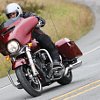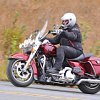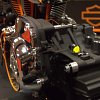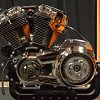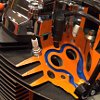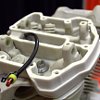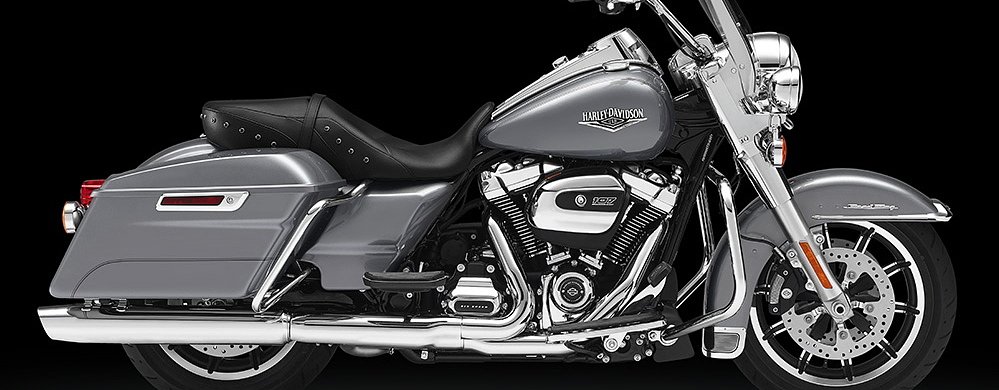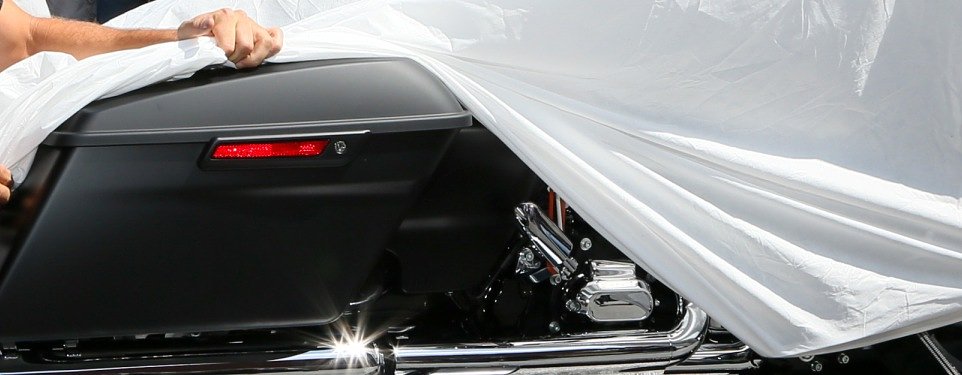“It’s like doing surgery on the Pope.”
Those were the words of Alex Bozmoski, Chief Engineer of New Product at Harley-Davidson. He had just given a room full of members of the motorcycling press a talk about the new engine that was announced a short while ago, beaming like a proud new father. (He did this pretty much all week.) This simile was how he laughingly described the problem of updating the Big Twin, the engine that powers Harley's flagship models, for the first time since 1999.
He’s right, of course. Everyone knows it needs to be done, but there are a million ways to screw up. Well, I rode a bike equipped with one. In fact, I rode quite a few bikes. And frankly, I have to say, I think Bozmoski had a right to have that big grin on his face. The new engine is very, very good. And this year, front and rear suspension underwent a makeover. The Rushmore updates of 2014 and 2015 are still fresh and new-feeling, so the addition of a different (better) engine and a different (better) suspension make the new batch of Touring bikes feel different (better) than the models of yesteryear.
Theory: What's in the Milwaukee-Eight
I touched on some of the new engine details when we covered Harley’s annual dealer meeting earlier this year, but I was able to gather more background at Harley’s press release. Harley predictably went to focus groups to figure out how to improve the Twin Cam. They showed us slide after slide during their presentation with customer quotes, but here’s what they all boiled down to: “I want more power, and I want the bike to run cooler. Also, don’t foul up the look, sound, or feel of the bike.” Basically, everyone wanted everything.

This engine design began with heavy use of 3-D modeling, which was downright futuristic. They’re able to 3-D print very large items, and Bozmoski told us with simpler things, like the air cleaner housing, they are able to run some tests with the 3-D printed item and not even go to the hassle of having one made of steel. It saves them time and allows the testing of many more designs than would be possible with conventional parts creation. I’m sure it must be helpful to the design team, too, to have correctly sized drivetrains that don’t weigh a ton to use for modeling. I was very impressed by the detail in the printed items I saw.

More power happened. The Milwaukee-Eight is pushing higher compression ratios than ever before (10:1 in the 107 ci variants, and 10.5:1 in the 114-incher). Displacement is obviously up, too: four more cubic inches were added to each over the engines they are replacing. This all yields 10 percent more torque over the outgoing Twin Cams. Not bad so far.
The Milwaukee-Eight is counterbalanced. The balance factor, for the nerds among us, is 75 percent. Bozmoski explained that non-native Harley riders seemed to like things smoother than their bar-and-shield brethren, but when the engines were completely balanced, The Faithful didn’t like it one bit. At this juncture, I think I should mention that I think Bozmoski was neurotic about this point; he’s a former NVH guy.
“Harley riders like the bikes to shake a little bit and put on a show at the stoplight,” he explained.
Our test bikes were very mellow. The mirrors shook a little at idle, but that was about as dramatic as it got. Bozmoski says the counterbalancer smooths low-engine-speed vibration, typically under 1,800 rpm or so. Rubber-mounting the engine comes into play for the higher rpm vibrations. This two-pronged approach to dealing with vibration works! This is the smoothest Harley Big Twin I’ve ever felt, and I bet our readers say the exact same thing.
Harley also dropped the Twinkie’s ion-sensing ignition. Instead, the internal happenings of the engine are now monitored by knock sensors. This new method of engine management keeps the powerplant’s ignition advanced juuuuust shy of detonation at every firing of a cylinder. The CT gearheads know that by advancing the ignition timing, the fuel has more time to burn within the cylinder, too, reducing the chances of the burn continuing in the exhaust tract. For those of you who have had a Twin Cam’s cat scorchin’ your right thigh, this will come as welcome news. More power and cooler running. I’m sold already. Of course, this also helps the engine stay cool, meaning cleaner emissions due to to tighter clearances.
“We dropped EGT’s [exhaust gas temperatures] 100 degrees,” Bozmoski said proudly.

Another bit of nifty tech in play is the use of low-tension piston rings - fairly sophisticated technology Harley has employed. Low-tension rings exert less pressure against cylinder walls than standard rings, and they’re a bit thinner, too. This reduction in friction reduces a significant amount of drag on the motor. All that power is rippin’ through an updated clutch, too. The 107 engines have a nine-plate unit, and 114 powerplants get one more plate. It’s possible to upgrade the nine-plate unit to a 10-plate, but the two designs use different clutch baskets, so it’s not as easy as just slamming another fiber disc and steel in the clutch pack stack.

The other big change was the return to a single cam. A single cam lowers the mechanical noise of the engine, which means other noises can be allowed to be more audible, like say, exhaust, a critical piece of the Harley sound. Hydraulic lifters are still being used in the valvetrain, with each pushrod operating a forked rocker. There is no provision to accommodate for left and right valve seat wear. Bozmoski assured us that testers did not see appreciable differences between the valves, though adjustable rockers are available for hi-po engine builds.
As an editorial aside, I believe the gentle rate of wear has to do with two things: first, the cooling fluid flowing in the “bridge.” Oil (or water, on the Twin-Cooled engines) flows near the exhaust valves to help carry away the heat of exhaust gases. Secondly, smaller valves likely mean lower spring pressures, which will also prolong the life of an exhaust seat.
The catalytic converter also got a redesign. It sits farther back, behind the transmission. Heat’s not as noticeable. It was chilly in Washington — in the low 60’s — where we were riding. I actually was able to easily feel the heat from the cat with my hands when I was trying feel where it was radiating from, and it was well behind my right leg. Nice. Another thing keeping the engine cool is simply a lower idle speed. That lower speed necessitated a larger charging system to keep from having a negative charge situation at the new, lowered idle speeds. Harley claims 50 percent more output, which is a whopper of an improvement on a touring motorcycle, which is likely to be loaded down with geegaws.

Other minor changes were ergonomic, but very welcome: the air cleaner tapers sharply at the rear, and the primary case is slimmer. This equates to more room for your knee on the right side of the bike, and less interference between the derby cover and your left ankle. The saddlebag retention system has changed, too. Gone are the finicky pins and brackets. Now a positive, self-torquing screw-in knob retains the saddlebags. It’s the little things in life, man. They work really well.

So what does all this mean to a Harley diehard? Things are still the same, but they are different. The most noticeable difference to me was the fact that Harley has all their upmarket Screamin’ Eagle options ready to go in the dealers. You can buy your bike, and exhaust, and a big-bore kit all at the same time, right now, ready to go.
“This is something we should have done years ago,” says Bozmoski. From a business perspective, I agree with him. You sell accessories with the big-ticket item. From the aftermarket perspective, I’m furious. Aftermarket stuff is awesome, and many riders will simply finance the easy-to-buy Screamin’ Eagle parts, rather than find an aftermarket item that is all too often better-engineered yet cheaper.
It also should be mentioned — if it’s not plainly evident — that the days of the infinitely rebuildable, easy-to-wrench, keep-it-for-your-grandkids Harley is done and gone. Bozmoski danced around the issue of the plain-roller crank bearings that were used to ill effect in the Twin Cam and carried forth to the Milwaukee-Eight.
“We didn’t see a need to use double tapered-roller bearings,” he said.
When I asked him why, then, Harley offers a kit for Twin Cams to convert back to that style of bearing — used from 1954 to 2001, and abandoned presumably due to cost — I got a simple answer.
“Customer perception. Sometimes customers think they need it.”
This is just pure speculation on my part, but I think his hands were tied, and he wanted to throw the bean-counters under the bus. Either way, the Milwaukee-Eight ain't got dual tapered bearings down below.
Here’s my take on things. If you’re familiar with the problems that plagued the Twin Cam, I think they’re now licked. Harley didn’t improve the quality greatly. I think they just managed to put together enough fixes that the package works. (I’m talking about the Lefty Bearing of 2008, the usage of a cam timing chain, which permits a little more “slop” in the lower end, and hydraulic tensioners for that cam chain, which helps keep the shoes from grenading as fast as they once did.) Look, H-D has to meet a price point.
I wouldn’t buy one of these for a “keep it forever” bike, but most people don’t want that type of machine, anyhow. If you’re dead-set on doing that, plan on putting some real money into a Milwaukee-Eight the first time it goes down for a rebuild. The aftermarket will have fixes to shore up any issues that crop up, just like they did with the TC. It won't necessarily be cheap, though. That rebuild might be sooner than later, though. Before we headed out to go ride, Bozmoski made sure to grab me to clarify a question I had asked him earlier.
“These engines’ top ends can be torn down completely in situ,” he said. In other words, in the frame.
So if you’re the hot-rod type, slamming a big, nasty jug kit in your dresser should be doable at home, and if you’re paying to have it done at the shop, it won’t cost you an arm and a leg. And if you like ‘em stock? Well, I asked Bozmoski when a Milwaukee-Eight pilot could expect to tear down his top end.
“We built ‘em to go for a 100,000 miles easy,” he claimed.
Practice: Riding the Milwaukee-Eight
To test these bikes, Harley flew a mess of us motorbike writer types out to Tacoma, Washington. After the extensive briefing on the engine, I was dying to get on a bike. H-D brought what seemed like one of everything. I selected a Road Glide, and fired it up. It started so easily; there was none of that hitching and coughing routine that came with the older bikes. Oh yeah, I forgot… this thing has decomp releases. (Automagic, of course.)

First, I must discuss the feel. The Milwaukee-Eight feels like the logical extension of the Twin Cam. It's actually remarkably similar in feeling. At idle, it feels and sounds like a Twin Cam, just smoother and better behaved. Once you twist the throttle, though, it becomes apparent something is different.
The normal low-end yank a Harley is known for is still present in spades. Where this engine is different, though, is up at the top end. Two-valve Big Twins simply run out of steam upstairs in the rpm range. The head design has always been a bottleneck; they just don’t flow well. Well, that has changed. I spent hundreds of miles banging the bike off the rev limiter. Why? It makes power up there. It was really fun to zip through twisties, whacking the throttle on and off and actually getting some decent engine braking out of this new engine. The engine now feels more linear, much less bottom-heavy.

The engine certainly looks like it belongs in the bike. Visually, it looks really similar to the Twin Cam, I think. (Right down to the fake “points” cover. Shame on you, Harley-Davidson!) Shifting is exactly as you’d expect: big and clunky. The shifts require a firm boot heel on either end of the heel-toe shifters, the travel is long, and the resulting clang is firm and authoritative, if a bit lacking in refinement. I’ve said it before, and I’ll say it again: You either love how a Harley shifts or you hate it, but this is no different than the bikes that came before it.
I’ve concentrated mostly on the engine here, because that’s the “new” item everyone wants to know about. The Rushmore updates still feel fresh and bright, and the new suspension they tossed in this year is such a welcome change. It’s not as good as the best aftermarket suspension, but it is finally acceptable. Hell, I think it’s even a little better than acceptable. Normal, knob-type preload adjusters can now be found on the rear shocks. I nearly cried tears of joy. The suspension is just so much better than the crap that used to come on these bikes.

To make sure I was being a well rounded writer, I spent varying amounts of time on some other bikes. In addition to the Road Glide, I tried a Street Glide, a Road King, another Road Glide, a CVO Street Glide, and even took a little jaunt on a Freewheeler trike. All performed well, but the notable vehicles here were the CVO bike and the Freewheeler. The CVO Street Glide had hair on its chest. I only rode a few miles on it, but that bike friggin’ ripped. I can’t wait to see that engine available in a lighter bike. A Low Rider S with a 114 in it would be a tire-shredder, for sure. The trike was also lots of fun, assuming that you can remember to steer where you want to go when riding them. (I never can.) There’s something really American about riding around the countryside on a hot-orange three-wheeler. Suffice it to say this to sum up my testing: I had fun. I like this new engine a lot.

Incomplete conclusion
I’ve been riding a snotload of touring bikes this year, all new, and I’ve been feeling worse and worse for poor old Harley. Up until I got wind of H-D’s new powerplant, I figured Harley’s goose was cooked. These other premium brands, some of them upstarts in the dresser category, were flat-out kicking Harley’s ass. There’s not a pretty way I can put that.

After the 2014/2015 Rushmore updates, this year’s suspension overhaul, and the brand-spankin’-new engine, I’ll say it plainly: Harley once again is offering a world-class touring machine. They’re back on top. Am I biased? Sure. I love Harleys. But I’ve ridden nearly every new premium dresser on the market, so I feel like I’ve got a good feel for what can be bought. Harley's got a good bike on their hands, maybe even the best — for now.
It’s too early to tell if the Milwaukee-Eight is the savior for the MoCo. Time will reveal if there are bugs to be worked out, but for now, I am impressed. Harley threw the kitchen sink at this project: high-tech methods and parts abound within the Milwaukee-Eight. Unlike competitors, creating this engine was not strictly about power, but about blending performance with a traditional appearance and feel, which is important to some of their buyers. They've also ensured that they can stave off full liquid-cooling for a little longer, which gives them time and breathing room to innovate their way out of the next engineering challenge. They changed while staying the same. I think they managed to keep things close enough to the status quo that they won’t lose customers, but they made the engine better enough that they will reel in new, non-H-D customers, mark my words.

I think I can con The Mothership into sending us one of these machines for the full shakeout review. In the meantime? I’m going to daydream about what a 114 in a Dyna chassis might feel like.





